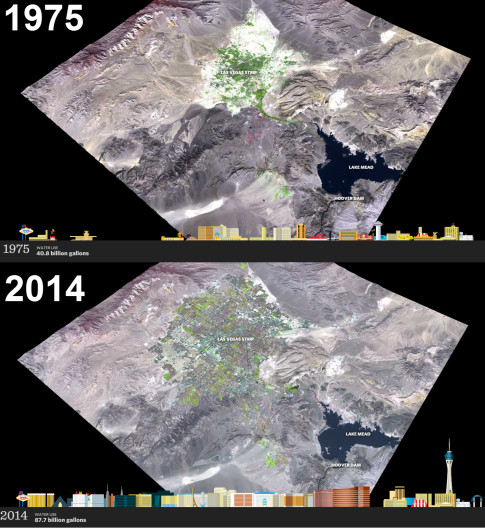– Leaking Las Vegas (ZeroHedge, June 9, 2015):
What happens in Vegas, stays in Vegas… apart from the water. As the following interactive chart from ProPublica shows, water usage in the greater Las Vegas region has more than doubled in the last 40 years and with the drought conditions, every reservoir is near record lows. Welcome To Las Vegas (while water supplies last).
Vegas Water History
1905 The Las Vegas Land and Water Company is formed to build and operate groundwater wells which the city then depended on for decades.
1922 The seven basin states sign the Colorado River Compact, estimating the river’s annual supply at 18 million acre-feet of water and dividing 15 million acre-feet between the northern and southern states. The river would eventually prove to flow with just 14.8 million acre-feet a year.
1928 The Boulder Canyon Project Act authorizes construction of the Hoover Dam and split the water shares up between states. Nevada only gets 97.8 billion gallons, while California is given 1.4 trillion gallons, an imbalance that complicates relations to this day.
1941 A pipeline is constructed by Basic Management Inc., to take water from the Colorado River in Lake Mead and deliver it to Las Vegas for the first time.
1956 Congress passes the Colorado River Storage Project, authorizing the construction of some of the largest dams on the river, including Glen Canyon, Flaming Gorge, New Mexico’s Navajo and Colorado’s Aspinall Unit.
1963 Supreme Court settles Arizona vs. California, deciding a key aspect of Western water law and allowing Arizona, Nevada and California to withdraw unlimited water from their tributary rivers without counting it against their share of the Colorado River, further straining the system’s supply.
1971 The first phase of construction on the Southern Nevada Water System is completed, enhancing Las Vegas’ reliance on the Colorado River for its water.
1989 Seeking more water to support growth, Pat Mulroy and the Las Vegas Valley Water District quietly file 148 applications for water rights in rural counties north of Las Vegas.
1990 Las Vegas’ daily water demand exceeds 300 million gallons per day.
1991 The Las Vegas Valley Water District receives a report warning the area will run out of water within five years. Pat Mulroy temporarily puts a moratorium on new building projects. Later that year the Southern Nevada Water Authority is formed, combining seven water districts in the Las Vegas Valley.
1992 The Water Authority gets permission from the U.S. Secretary of Interior to temporarily use extra water from the river, which for a few years flowed with more water than the states had divided up.
1994 Nevada’s state engineer allows the Water Authority to take additional water from the Virgin River, water which would have otherwise flowed into Lake Mead.
1998 The Southern Nevada Public Lands Management Act is passed, giving Nevada a say in how federal lands are sold and allowing Las Vegas to rapidly expand. The Water Authority gets a 10 percent stake in land sales, tying its revenues directly to growth.
1999 Las Vegas’ maximum daily demand exceeds 400 million gallons.
2001 A year into the start of the drought, California, Nevada and Arizona agree to divide up surplus water from the Colorado River.
2002 The Water Authority completes a $2.1 billion tunnel to double the amount of water it can take from Lake Mead. That same year, drought ravages the basin. The Colorado flows at 25 percent of normal. Pat Mulroy throws out her 50-year water plan.
2003 Mulroy’s water authority pays Las Vegas residents up to $2 per square foot to rip out front lawns.
2005 SNWA decides to build a third, lower intake tunnel from Lake Mead to ensure it can, as Mulroy said recently, “take the last drop” when water levels fall.
2007 As drought drags on, the Colorado River basin states reach an agreement to divide water shortfalls between them in case water levels in Lake Mead drop below 1,075 feet, a trigger that signals a water emergency.
2012 The United States reaches an agreement with Mexico, which has long been entitled to nearly 489 billion gallons from the river, to allow Mexico to store some of its water for future use in Lake Mead. That same year the U.S. Bureau of Land Management comes out in support of the Water Authority’s proposal to build a water pipeline from rural Nevada to Las Vegas.
2014 Pat Mulroy retires after 26 years as Las Vegas’ top water official and having added significantly more water to the city’s annual supply. But the city is in its 15th year of drought, and the Water Authority projects its water demand will continue to rise beyond what the city is currently capable of providing.
Sources: USGS, NASA/USGS Landsat, Google, U.S. Census, Las Vegas Valley Water District, Southern Nevada Water Authority, U.S. Bureau of Reclamation, Department of Justice, State of Nevada Division of Water Resources, Wyoming State Water Plan, U.S. Department of the Interior Bureau of Land Management, Clark County Office of Public Communication.

Geomorphologically, Las Vegas could never support a permanent population of 600K, let alone the doubling up with tourism.
One only has to look at its spread, in a dry, barren environment to realise the futility of its existence and limited future based on falsity.
Its existence, based on parasitic enjoyment, gambling, entertainment, and the ultimate den of iniquity was the climax of mid 1900 U.S. decadence, based on milking one water source for both power and sustinence, with no consideration for the long term.
It will end up like one of those classic new Chinese Ghost Towns.